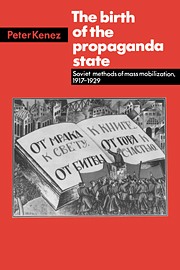Book contents
- Frontmatter
- Contents
- List of illustrations
- Preface
- Introduction: The Soviet concept of propaganda
- Part I The Civil War
- Part II The new economic policies
- 6 Political education
- 7 The literacy campaign
- 8 The Komsomol in the 1920s
- 9 The golden age of the Soviet cinema
- 10 The press and book publishing in the 1920s
- Conclusion and epilogue
- Notes
- Glossary
- Bibliography
- Index
8 - The Komsomol in the 1920s
Published online by Cambridge University Press: 02 December 2009
- Frontmatter
- Contents
- List of illustrations
- Preface
- Introduction: The Soviet concept of propaganda
- Part I The Civil War
- Part II The new economic policies
- 6 Political education
- 7 The literacy campaign
- 8 The Komsomol in the 1920s
- 9 The golden age of the Soviet cinema
- 10 The press and book publishing in the 1920s
- Conclusion and epilogue
- Notes
- Glossary
- Bibliography
- Index
Summary
The Soviet political order was born out of the anarchy of the Civil War. Russia, which had always been undergoverned, now fell apart: The weak ties between citizen and government snapped. The decisive task was to rebuild institutions, to restructure authority, and thereby to make the political and economic order function. The Bolsheviks, of course, had no plans for the circumstances in which they found themselves; no one could have foreseen the sequence of events that left Lenin at the head of Russia's government. Nevertheless, the Bolsheviks brought with them from their revolutionary past institutions that could be adapted for the new tasks. Even more important, they had developed a mentality that turned out to be timely and conducive to success.
The most visible of these institutions, the one that best embodied Leninist principles, was the Party. Its role in the Civil War and in the period of economic reconstruction has been justly stressed by Soviet historians and publicists. Western scholars correctly described the concept of the Party as Lenin's greatest contribution to twentieth-century government theory and practice. The accomplishments of the Party–as a formulator of policy, as a recruitment agency for a new governing elite, as a supervisory body, and as a purveyor of doctrine in a new and exotic ideology – are self-evident.
Nevertheless, our appreciation of the importance of the Party must not blind us to the fact that it was only a part, albeit the most visible part, of a new political system. A strength of the Party was its elitism. It motivated important cadres by giving them the conviction that they were more important, better, and therefore more powerful than the average citizen.
- Type
- Chapter
- Information
- The Birth of the Propaganda StateSoviet Methods of Mass Mobilization, 1917-1929, pp. 167 - 194Publisher: Cambridge University PressPrint publication year: 1985



